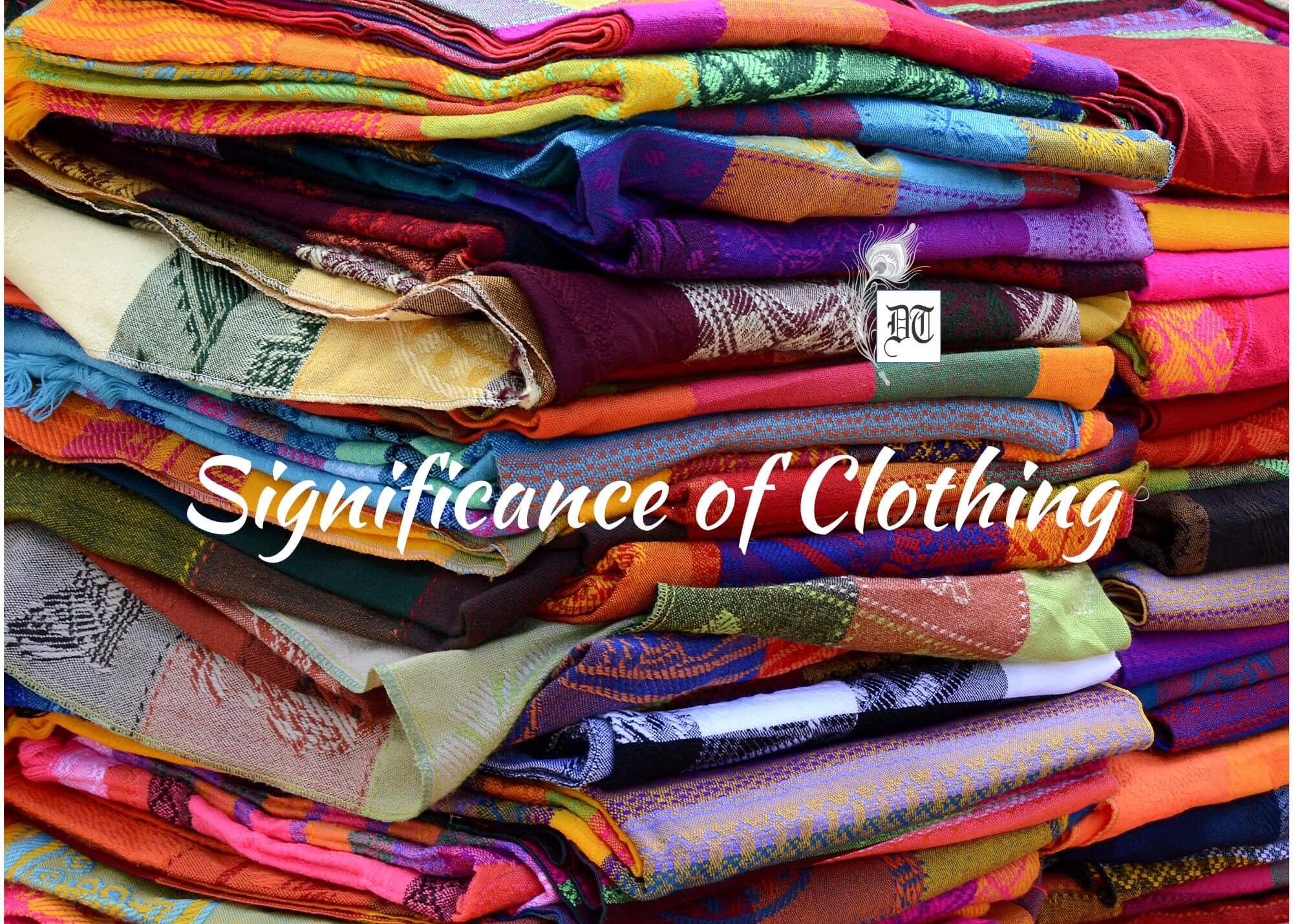In the sixth and last part of the erudite research article, Fashionista Shameena tells us about turbans and other headdresses, particularly for women. She traces the current trends, tracing its antiquities, in the weekly column, exclusively for Different Truths.
Turban evolves and turns chic when women adorn it in various parts of the world.
Kerchief and Head Wrap
The kerchief, a cloth covering the head, from the French courier (to cover) and chief (head), is usually worn by women. Traditionally, European peasants wore a small cloth tied under the chin while working outside; thus, the kerchief became associated with rural women and later with lower-class city residents. As late as the 1950s, a domestic servant girl in Madrid, Spain, was considered breaking social barriers by wearing a hat rather than the kerchief assigned her class. Also called a bandanna, the kerchief did become a practical middle-class head cover used for riding in open automobiles.
The head wrap, a kerchief worn by tying over the forehead, is believed to have travelled with women from Senegal and Gambia (West Africa) along the slave trade routes to Caribbean Islands and ports in North and South America. The falla, a strip of cotton cloth tied around the head in the eighteenth-century Gambia, may be the precursor to the head wrap later identified with adult female slaves. Imported into New Orleans possibly by way of the French colonies Martinique and St. Dominique, the head wrap when worn by free women of colour, became a nineteenth-century fashion called Tignon, created from brightly-colored madras, occasionally adorned with jewels and feathers.
Spanish Mantilla
Usually black or white, the mantilla may derive from Manton (mantle or cape) worn both indoors and outdoors during the Muslim rule of Spain. Mantillas (small capes) were originally head coverings of handmade silk lace, often imported from Chantilly, France, and worn by aristocratic 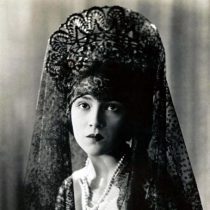 women, as documented in portraits by Velasquez (c. 1625) and Goya (1792). By the nineteenth century, a popular hairstyle, the chignon, provided suitable positioning for high, decorative combs (tortoiseshell, silver, ivory) to support larger mantillas-some measuring 7 × 3 feet-which drape over the shoulders. This style is commonly worn for special events such as Holy Week processions and community fiestas. Red-silk knobbed mantillas are occasionally worn by unmarried young women to bullfights. Romantic myths transported to Spanish colonies in Latin America (Mexico) and the Philippines depict señoritas in white mantillas on balconies listening to guitar-playing suitors. Because of their cost, mantillas are often passed down from mother to daughter as family heirlooms. The lace mantilla, without a comb, was a French fashion during the 1920s and 1930s.
women, as documented in portraits by Velasquez (c. 1625) and Goya (1792). By the nineteenth century, a popular hairstyle, the chignon, provided suitable positioning for high, decorative combs (tortoiseshell, silver, ivory) to support larger mantillas-some measuring 7 × 3 feet-which drape over the shoulders. This style is commonly worn for special events such as Holy Week processions and community fiestas. Red-silk knobbed mantillas are occasionally worn by unmarried young women to bullfights. Romantic myths transported to Spanish colonies in Latin America (Mexico) and the Philippines depict señoritas in white mantillas on balconies listening to guitar-playing suitors. Because of their cost, mantillas are often passed down from mother to daughter as family heirlooms. The lace mantilla, without a comb, was a French fashion during the 1920s and 1930s.
Royal Headdresses
Since antiquity, rulers have worn impressive and costly headdresses, visible symbols of their power and claims to divinity. Prehistoric peoples stressed survival; their practical head coverings were made of animal skins in northern regions, twisted straws in warm climes. With the evolution of complex 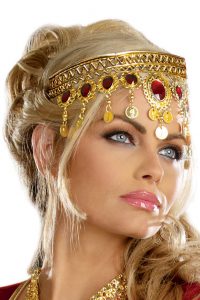 population centres, textile production and class stratification emerged in Mesopotamia, which resulted in Sumerian turbans and head wraps (3000 B.C.E.), and later splendid regal twisted hair and headbands during the Akkadian era (2250 B.C.E.). Egyptian royal ceremonial headdresses of the New Kingdom (c. 1580-1085 B.C.E.) were extremely precious, some made of gold decorated with inlaid carnelian, coloured glass, and ostrich feathers.
population centres, textile production and class stratification emerged in Mesopotamia, which resulted in Sumerian turbans and head wraps (3000 B.C.E.), and later splendid regal twisted hair and headbands during the Akkadian era (2250 B.C.E.). Egyptian royal ceremonial headdresses of the New Kingdom (c. 1580-1085 B.C.E.) were extremely precious, some made of gold decorated with inlaid carnelian, coloured glass, and ostrich feathers.
The Ancient Greek korone (crown), a golden circlet or gold wreath, symbolized political and military power during the fourth-century B.C.E.Macedonian era, while Olympic champions were crowned with nature cult head-pieces: laurel, olive, pine, or celery wreaths. Adopting Greek depictions of gods, especially Apollo, many Roman emperors were portrayed on coins wearing the laurel wreath. Christian monarchs since Charlemagne have worn bejewelled crowns with a cross symbolizing their power as God-given.
Gigantic turbans, three to four times the head size, usually wrapped around a tall hat, adorned the heads of Ottoman sultans including Süleyman I in early sixteenth-century Istanbul. For public occasions, Manchu royalty in China wore ornate cone-shaped, silk-covered head-pieces, with imperial insignia above a tall gold finial intricately decorated with dragons, Buddhas, and pearls. But the nonofficial headdress worn by the Empress Dowager Cixi and her courtiers (1903) was more striking. Bat-wing shapes of false hair and black satin were arranged over a wide frame with large artificial flowers and long silk tassels dangling from the sides.
For centuries, Japanese emperors have worn the black lacquered ceremonial headpiece (kanmuri) with a birdlike tail made of fine horsehair, associated with Shinto priests and courtiers. Because of his role as intermediary between humans and gods, only the emperor wore the tail vertically.
Glass beads, cowrie shells, and feathers are the precious materials used for elaborate headdresses of many African chieftains. A Yoruba king in Nigeria, who represents the collective destiny of his people, wears a tall conical beaded headdress asserting his authority in social, political, and religious matters. Numerous strands of beads hang from the royal headdress hiding his face, which is considered powerful and 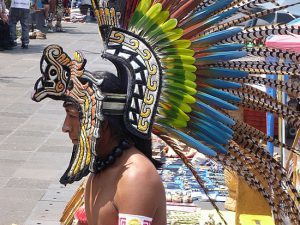 dangerous. The headdress, which represents the king, must be given reverence in his absence.
dangerous. The headdress, which represents the king, must be given reverence in his absence.
A 46-inch-high Aztec headdress (kopilli ketzalli), popularly called “Montezuma’s Crown” and adorned with over 400 Quetzal bird feathers, is exhibited at Vienna’s Hofburg Museum of Ethnology in the early 2000s. For Aztecs, the number 400 represented eternity; only the highest-ranking ruler could wear 400 feathers of this sacred bird, associated with wisdom, peace, and freedom. The headdress supposedly was taken by Spanish invaders under Cortez and sent in 1524 as a present to Hapsburg ruler Charles V, the Holy Roman Emperor, and king of Spain. Since the early 1990s, Yankuikanahuak, an association fostering revival of native Indian cultures supported by the Mexican government, has been lobbying the United Nations and the Austrian government to return this sacred relic to its rightful homeland. Similar efforts have taken place in the United States. Under the Native American Graves Protection and Repatriation Act, an eight-foot-long war bonnet, made of thirty-five sacred bald and golden eagle feathers each measuring one foot, and claimed to have belonged to the renowned nineteenth-century Apache Chief Geronimo, came under government protection for a return to tribal ownership.
Wedding Headdresses
In many cultures and religious traditions, elaborate wedding headdresses become ritual objects. The Mien mountain tribal peoples of Laos and Thailand in the Golden Triangle emphasise a complex structure on the bride’s head. Her hair, coated with beeswax, is pulled through a tube projecting from a large board on her head above which a vault (like a roof truss) is created from bamboo sticks. A red-embroidered patterned fabric covers the whole ensemble. After two days of ceremonies, the headdress is removed indicating the bride’s acceptance as a full member of the groom’s household.
For festivals, including weddings, Hmong (Miao) women in China’s Yunnan Province wear an elaborate 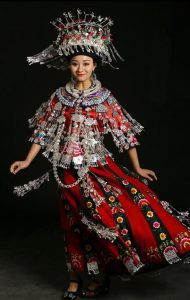 black scarf measuring to 35 feet long that is wrapped around the head creating a plate shape. The headdress features an embroidered belt with dangling tassels or coins around its edge. Decorations include amuletic symbols: a spiral motif representing family; triangular patterns as “sacred mountains” protecting against evil spirits.
black scarf measuring to 35 feet long that is wrapped around the head creating a plate shape. The headdress features an embroidered belt with dangling tassels or coins around its edge. Decorations include amuletic symbols: a spiral motif representing family; triangular patterns as “sacred mountains” protecting against evil spirits.
Traditional Japanese brides wear an elaborate hair-style called Bunkin-Shimada. Hair decorations include a comb (Kushi) and gold or silver multithreaded string folded in back in an elaborate shape. Hand-painted, lacquered floral-motif hairpins (kanzashi) may depict good-luck symbols such as pine trees for durability. Matching comb-and-hairpin sets are sold or rented in bridal stores. A white brocade band or hood (Tsuno-Kakashi), matching a white kimono, covers the elaborate bridal-adorned coiffure. White symbolizes the bride’s willingness to “colour herself as the husband wishes.” The term Tsuno-Kakashi combines the words for “horn” and “concealer.” It is said the white hood hides horns of jealousy or hatred the wife might have toward her husband, in-laws, or neighbours. At ceremony’s end, the bride removes the white headdress signifying she has left her family and adopted his.
In imitation of Ming empress crowns, Chinese brides wear an ornate phoenix headdress made of tiny gilded silver butterflies, flowers, and fruits dangling from wires, with inlaid kingfisher feathers (fertility and good-luck symbols) and embellished with strings of pearls hiding the bride’s face. A large red veil completely covers the bride’s head. The symbolism of the phoenix headdress and dragon motif on her robe associates the couple with the royal family, suggesting they are “emperor and empress” for the day.
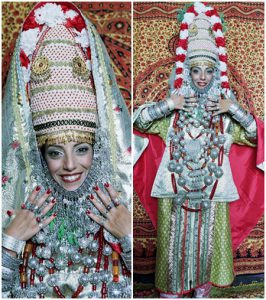 Jewish wedding headgear incorporates local ethnic variations. One ornate example is the Yemenite bridal Gargush, or hood, with its elaborate metallic ornamentation. Every day Gargushes are black cotton or velvet with a band of jewellery pendants (agrat), tiny silver rings, discs, and balls dangling over the forehead. Costly bridal Gargushes are crafted from gold brocade decorated with golden agrats, golden chains (khneishe, salsa), valuable coins, and fine filigree pins (koubleh) of geometric shapes.
Jewish wedding headgear incorporates local ethnic variations. One ornate example is the Yemenite bridal Gargush, or hood, with its elaborate metallic ornamentation. Every day Gargushes are black cotton or velvet with a band of jewellery pendants (agrat), tiny silver rings, discs, and balls dangling over the forehead. Costly bridal Gargushes are crafted from gold brocade decorated with golden agrats, golden chains (khneishe, salsa), valuable coins, and fine filigree pins (koubleh) of geometric shapes.
Crowns, wreaths, and veils are wedding headwear popularly used for Christian rituals. In Russian Orthodox ceremonies, ornate royal-style crowns with Christ and the Virgin icons are held over the bride and groom’s heads. The couple is recognised as ruling a new kingdom, the home, where they are urged to live together as moral Christians.
Throughout Europe, peasants held spring flower festivals (Christian substitutes for earlier pagan fertility rites) and some groups adopted them for wedding celebrations. The white lace veil with orange blossom wreath became a classic after Queen Victoria’s attire worn at her 1840 wedding to Prince Albert.
In the twenty-first century, Greek Orthodox couples wear wreaths of real, fabric, or artificial flowers joined together by a long ribbon representing their marital union. A similar practice of combining wedding headpieces is used by Buddhist couples in Thailand, where round white “Circles of Eternity” are joined by long strings.
(Concluded)
©Shameena Abdurahiman
Photos from the Internet, sourced from the author
#HeadDress #WeddingHeadDress #RoyalHeadDress #DurbanFashion #HeadDressHistory #FashionFunda #DifferentTruths

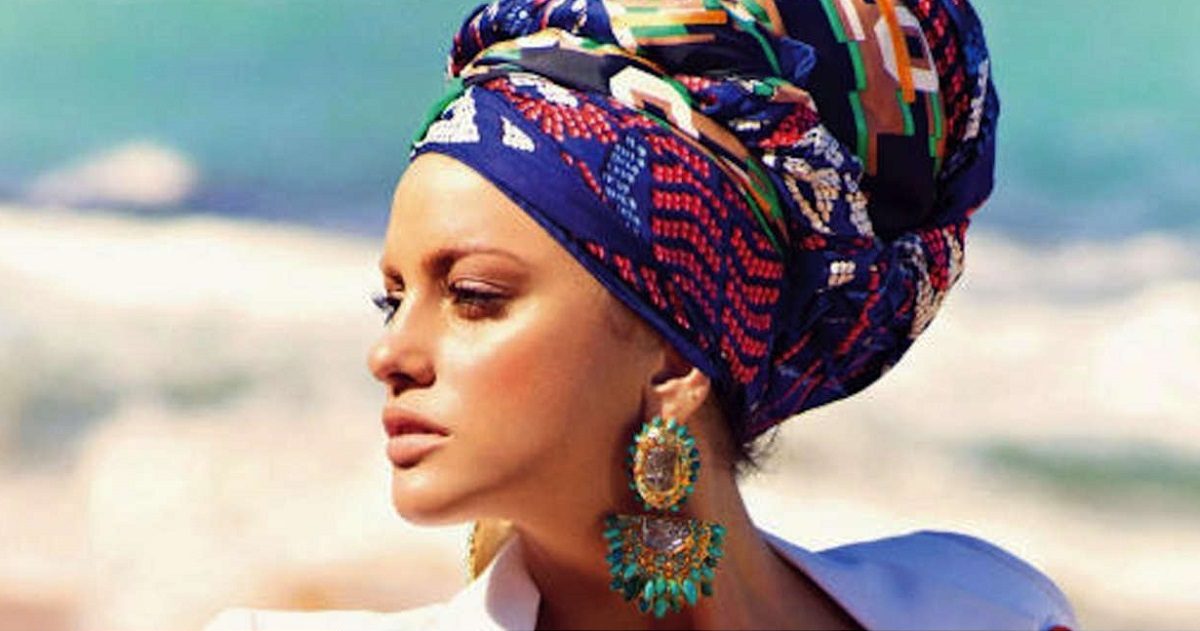
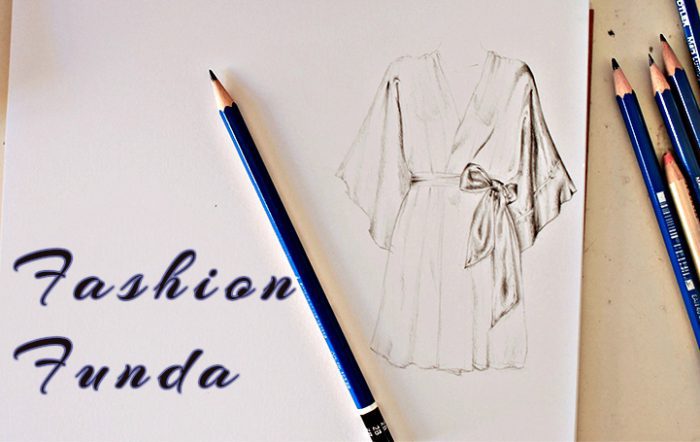



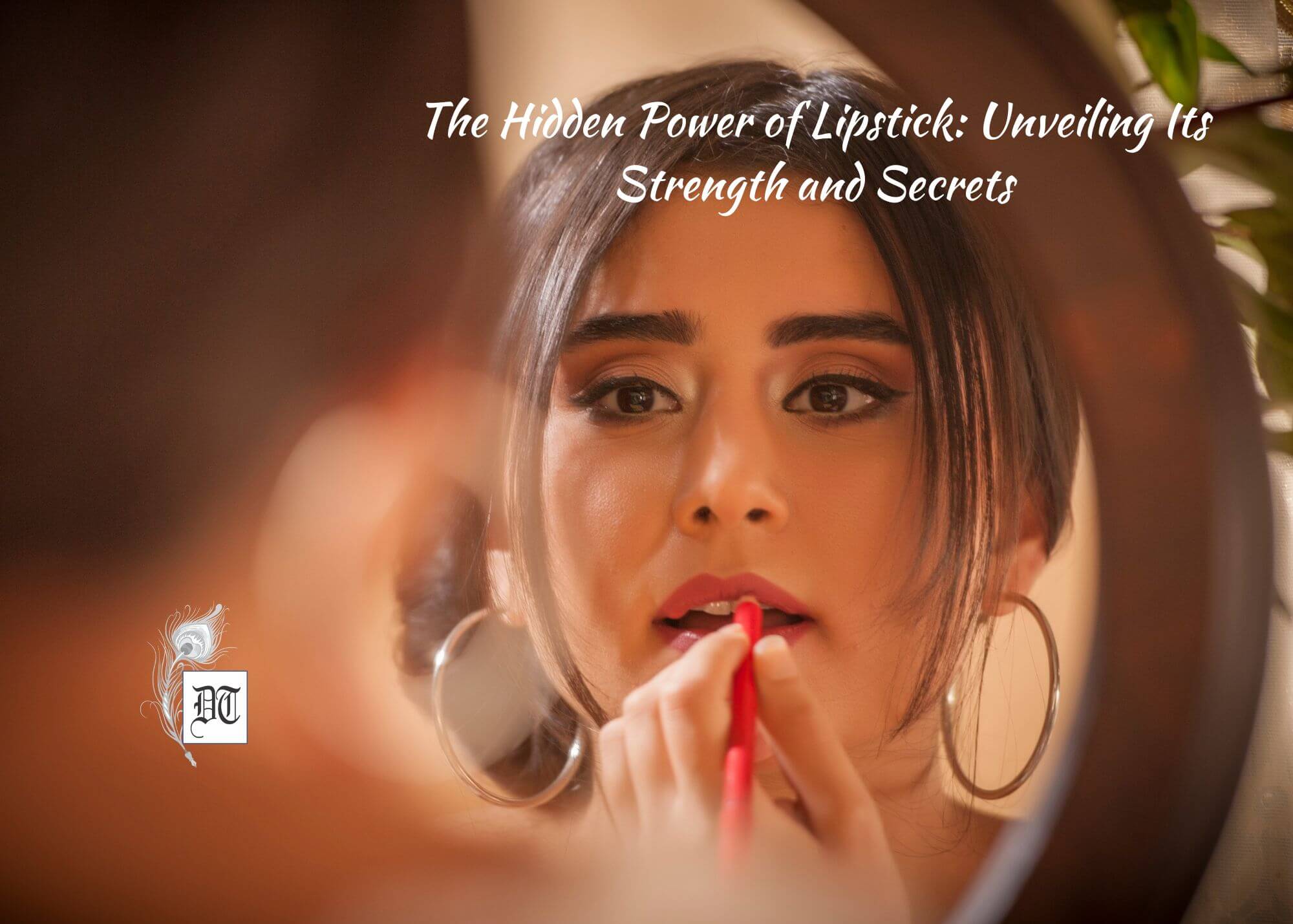

 By
By